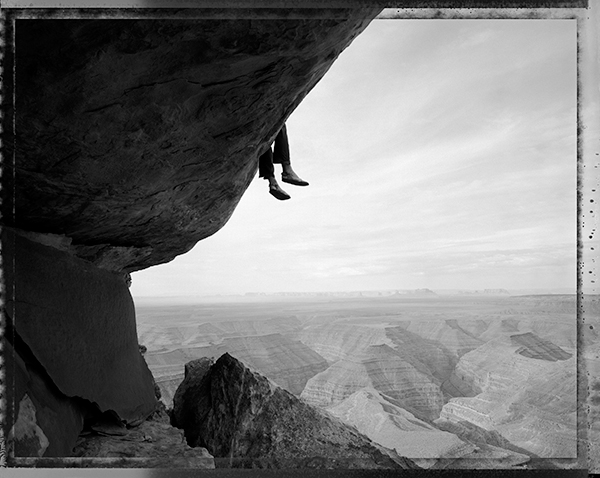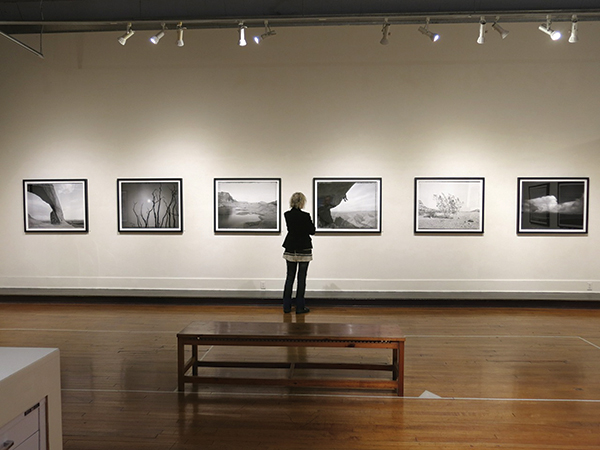Mark Klett Then + Now

Contemplating the View at Muley Point, Utah, 5/13/94
from Revealing Territory
archival pigment print on Museo Photo rag, printed 2014
32 x 40 inches, © Mark Klett 1994, courtesy Etherton Gallery
Photographer Mark Klett is a modern day enigma. Known world-wide for his stunning large-scale black and white images that trace and invoke past landscape photograph pioneers, he also brings a modern sensibility to his work that is infused with a wide range of emotions. Rarely are artists so agile at capturing both the majesty of their environments along with the complex socio-economic impact of modern man on the same spaces. In Klett’s new show at the Etherton Gallery entitled Then + Now, the photographer again demonstrates both his technical artistry and his keen powers of observation.
The exhibition is divided into three sections, the first features a look at several now-classic black and white images of western landscape that are familiar and compelling for their beauty and composition. Long known as one of the finest landscape photographers in the country, if not the world, these images reinforce the beauty of the environment that many of us will never see firsthand. With sweeping vistas and towering rock forms these images look like stills from a science fiction film. The next part of the show features these same black and white images on a larger scale than they have been seen before. This transformation is quite remarkable for a number of reasons. First, the amount of detail that has been captured and not seen before is staggering. Secondly, the images somehow manage to convey an even more powerful respect for the space that is being portrayed. After seeing these jumbo-sized works, it’s hard to go back to the originals.
The final set of images in the main exhibition, from the Camino del Diablo series, are entirely new, and are in glorious color. Klett again revisits his passion for history, as for this series he has retraced the route of an 1870 geological survey and photographed what might have been seen along the way. The pages from the book describing the landscape are displayed adjacent to each image, which adds to the experience of seeing this landscape for the first time in both words and images. Ironically, the location of this trek is now part of the Barry M. Goldwater bombing range and US military training area in the Sonoran Desert. As in the past, this juxtaposition of man and nature is handmade for Klett’s eye to document the intersection of man and nature in an uncanny way. These images are drop dead gorgeous and also a little sad. The scale of man in several puts perspective into play, along with the debris that has been left behind, but in the end it’s the staggering beauty of nature at outweighs anything humans are doing.
Largely unchanged since the era of the original descriptions in the narrative accompaniment, one can easily imagine being marooned in this foreign landscape in the late 1800s following a dangerous and hard stagecoach journey into the newest area of the United States, and expressing wonder at the exotic flora and fauna. Of particular note is one image of a crescent moon over a barely visible mountain range that sucks the viewer into its rich and inky black midnight tones. Another personal favorite in this series is the beautiful bowl of stars on display in another night scene, something that is hard to imagine to us city-dwellers—sad creatures who rarely see anything but the brightest stars due to urban light pollution. Equally startling though is the image of a military training compound constructed out of shipping containers to resemble a mosque. The desert life around the obstruction is a riot of color and texture that lets us know the desert will reclaim this interloper soon, as this desert is clearly standing in for another region
This body of work was recently vetted in a New York Times opinion page piece due to its exhibition at the Pace McGill Gallery where the retracing of the dangerous journey from 1870 and again today in an active bombing range that borders Mexico, is recognized as no small feat. While it was impossible to know if the route documented by Klett was exactly the same one taken in the 1870s, the fact that the wilderness still exists and continues to beguile, is the point.
Also on display as part of the show is a series of intimate images entitled Time Studies that track celestial movements in a single image. These are both works of art and scientific observations that only Klett could merge and make fascinating.
Mark Klett Then + Now is on display at the Etherton Gallery, located at 135 S. sixth Avenue in downtown Tucson. The show is up through March 21 and is free and open to the public Tuesday thru Saturday 11am – 5pm and by appointment at 624-7370.

Category: Arts, DOWNTOWN / UNIVERSITY / 4TH AVE




